Repair of Stinol refrigerators: common problems and how to fix them
The Stinol brand is popular among connoisseurs of high quality and reasonable cost.The reliability, high-quality assembly, functionality and durability of these devices are beyond doubt among consumers. But technology remains technology and, despite careful use, sometimes it breaks down.
Repairing Stinol refrigerators is not a problem, since service centers are available almost everywhere. You can also repair the equipment yourself. The article we presented describes in detail the causes of typical breakdowns and methods for restoring the performance of refrigeration machines.
The content of the article:
Operating principle of a typical Stinol unit
Range refrigeration units Stinol is represented by a wide range of models with different performance characteristics. All of them belong to evaporative or compression type devices. This means that their design necessarily includes a compressor and an evaporator. Let's look at how they work.
To cool the working chambers of the equipment, a so-called refrigerant is used. The composition is a liquid that can evaporate at a certain pressure at room temperature.
Most often, R22 refrigerant is used as a refrigerant, but there may be other compositions. All types of refrigerants are called freons.
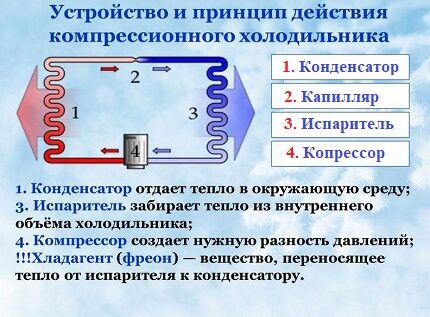
The work cycle occurs as follows. Liquid freon is fed into the die. This is a narrow nozzle in the form of a fragment of a capillary tube through which the refrigerant is injected into the evaporator.
The latter is made in the form of a coil, which allows heat exchange to occur with maximum efficiency. Inside the evaporator, freon quickly expands and transforms into gas, absorbing a large amount of heat.
As a result, the temperature inside the refrigerator or freezer compartment drops. If you constantly pump refrigerant into the evaporator, the pressure in it will increase sharply and the evaporation process will stop.
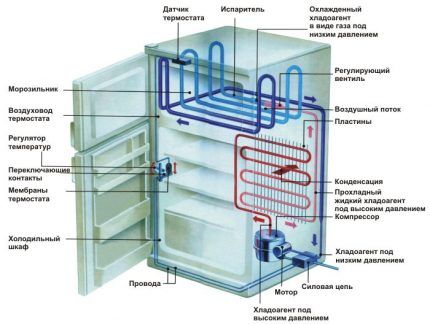
Therefore, freon vapor is continuously pumped out by the compressor and supplied to the radiator. This is another coil located on the back of the refrigeration unit. Here, the refrigerant vapor condenses and releases heat.
Next, liquid freon is fed into the die and the cycle is repeated. The main feature of such a system is the presence of moving parts and mechanisms that can sooner or later fail.
Refrigeration units with one or two compressors are produced under the Stinol brand. In the latter case, it becomes possible to separately control the freezing and refrigerating compartments, each of which is serviced by its “own” compressor.
This is convenient, but significantly complicates the system, as well as its maintenance and repair. In addition, the brand produces No Frost equipment and models with a drip defrosting system.
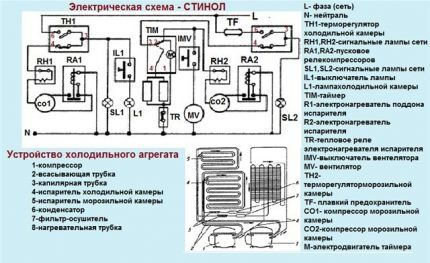
Electrical system design
Normal operation of any compressor refrigerator is ensured by an electrical circuit.
In its simplest form, it includes several elements:
- A thermostat responsible for maintaining a certain temperature.
- Thermal protection relay that prevents the compressor from overheating.
- Electric motor.
- Starting relay responsible for starting the motor.
The work cycle occurs as follows. When voltage is applied to the device, current flows through thermostat with closed contacts, a forced defrosting button, then through the thermal protection relay to the starting relay and to the working winding of the motor.
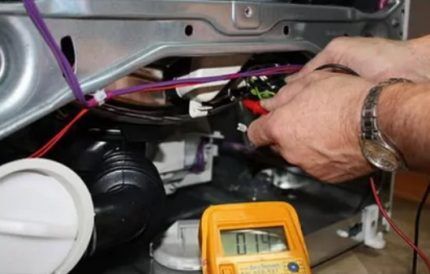
Since the motor shaft is stationary, the current flowing through its working winding is much higher than the rated value. This is necessary because the design start relay provides for the closure of contacts on the starting winding only when the rated current is exceeded. Thus, the relay transfers the current to the starting winding, the engine begins to rotate, and the voltage in the working winding disappears.
The motor continues to operate normally, but the refrigeration unit begins to freeze. When the previously set temperature is reached, the thermostat is activated.
It opens its contacts and current stops flowing to the motor. Refrigerator compressor stops.When the temperature changes, the thermostat contacts close again and the cycle repeats.

To protect against overheating that is dangerous for the motor, a thermal protection relay is provided. Its main element is a flexible bimetallic plate. When it reaches a dangerous temperature, it bends and opens the contacts; the cooled element “falls” into place and closes them.
Overview of typical breakdowns
It is clear that if equipment stops working, it requires repair and sometimes replacement. However, there are signs that indicate that the owner needs to pay attention to his unit and, perhaps, invite a technician.
Normally, the compressor should operate without excessive noise and turn on/off periodically. Continuous compressor operation is a direct signal of a malfunction.
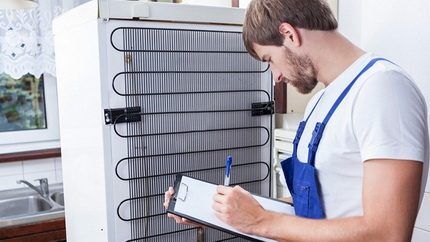
The temperature inside the refrigerator and freezer compartments must correspond to the set temperature. There should be no excess frost inside the freezer, and water should not accumulate in the refrigerator compartment. A variety of factors cause breakdowns.
Most often this is due to improper operation or installation of the device, mechanical damage, or environmental influences, for example, too high a temperature in the room. Power surges in the network are also very dangerous.
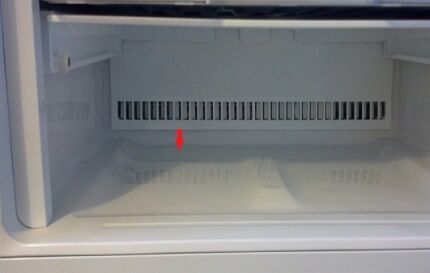
If the engine runs continuously and the temperature drops extremely low, the thermostat is most likely to blame. If it breaks, a different picture is possible. The unit refuses to start and defrosts, the compressor does not work.
In this case, the compressor will work without shutting down, and ice may appear in the evaporator. There may be a refrigerant leak in the cooling circuit. This problem is more typical for equipment with a bottom freezer.
There is a metal tube running along its perimeter, which can corrode in about 6-7 years. In this case, it becomes a source of freon evaporation.
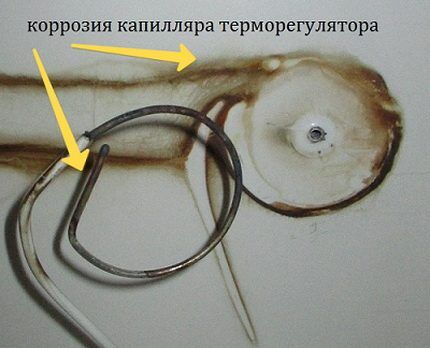
If there is a leak, the freezer will continue to work, but the refrigerator compartment will not. Corrosion can occur in both the evaporator and condenser. Repair in such cases is impossible, only replacement of damaged elements.
Quite often, Stinolov owners turn to repairmen with compressor problems. This could be a jammed motor mechanism. The engine will turn on, but not rotate, but only hum. It will work after a short time thermal protection relay.
Short circuits in the working or starting winding of the motor are also common. Less often the capillary pipeline fails. This can be noticed by an increase in temperature inside the refrigerator and freezer compartments and the appearance of ice on the evaporator.
The engine will run almost without stopping. All of these are typical breakdowns that most likely will have to be dealt with by a technician.
DIY Repair Guide
A user, even a little familiar with technology, understands that it is impossible to give detailed instructions for repairing equipment of a certain brand. The models are too different in their technical characteristics. We can only give general recommendations for the repair of individual components.
#1. Compressor of the device and its suspension
The design of the compressor of a refrigeration unit is quite simple. But at the same time, its independent repair is practically impossible. Frequently occurring inter-turn short circuits of the windings require replacement of the compressor.
Amateur craftsmen who try to rewind them usually waste time and effort. The reason for this is moisture and dust mixed with air that get inside the compressor during operation.
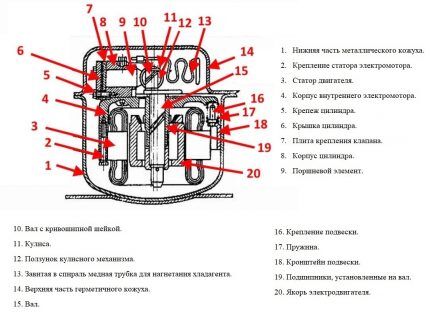
As a result, the unit still has to be changed. Masters do not advise doing this. Another thing is the compressor suspension. Due to its deformation, malfunctions of the entire unit are possible.
First of all, it is worth checking the elasticity of all its mounting legs. It should be about 8-10 mm or even more. If this is not the case, you will have to replace the shock absorbers, which is not expensive or difficult.
The main difficulty will be that the compressor is massive and can break the cooling circuit tube with its weight.Therefore, when replacing shock absorbers, you should securely fasten the unit in the working position and handle it as carefully as possible.
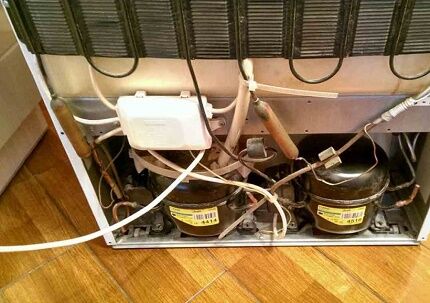
In the latter case, you should wrap it in cloth or felt and secure this bandage with wool or cotton thread. It is strictly not recommended to use synthetics or foam rubber.
They will become brittle or stick together as the temperature changes. In any case, there will be no benefit from them. Such a “bandage” will not only solve the noise problem, but also protect the tube from premature wear.
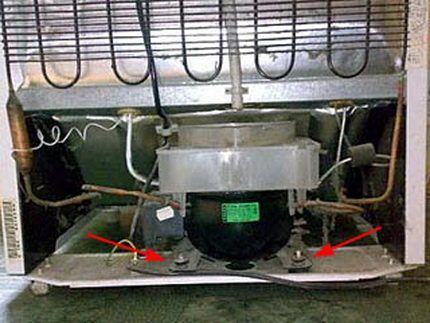
Another common problem is reducing the amount of freon. After watching enough videos on the Internet, some craftsmen are trying to do the refueling themselves. Masters strongly do not recommend doing this.
It will be possible to fill in freon, but whether the unit will be able to work after that is a big question. Water vapor and dust will inevitably enter the cooling circuit during the refueling process, which will subsequently lead to failure.
Besides, refrigerant injection a standard compressor assumes its operation on a wet run in a forced way. And this is extremely dangerous. The best thing you can do for your compressor in this case is to invite a qualified, licensed specialist who will perform the necessary work.
#2. Protection and starting system
The starting and thermal protective relays are usually combined by designers into a common unit.In order to get to it you will have to drill out the rivets holding the cover in place.
After repair work, it is best to place it on plastic glue and “grab” it with screws. The contacts can be considered the weakest points of the node. They often become dirty or melted. Basic cleaning will help here.
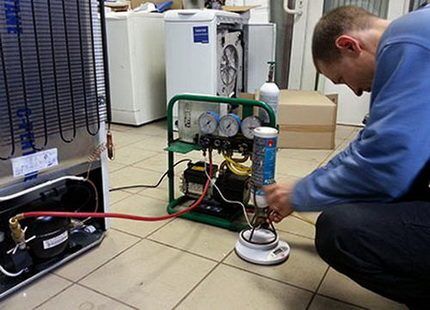
Another “dangerous” area is the starter core. It may be filled with dust, which causes the starter contacts to stick. The problem may also be in the bimetallic strip. It can lose some elasticity over time. If the part is slightly curved when cold, it is enough to give it the desired shape.
Loose adjustment screws can converge, and then the compressor begins to operate as if there are interturn short circuits on both of its windings. To solve the problem, simply unscrew the screws to the required clearance. It is about 0.15-0.25 cm. And clean the current protection contacts.
#3. Refrigeration unit thermostat
The design of thermostats used in refrigerators may vary. In general, there are two types of such elements: electronic and thermomechanical.
The former are used in electronically controlled devices and are a group of detectors and thermistors connected into a single unit with a control board. Only a certified electronics engineer can attempt to repair anything in such a system.
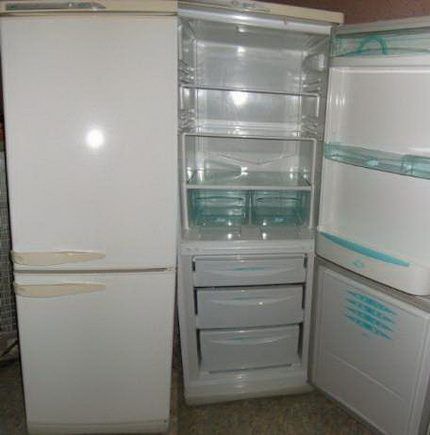
The thermomechanical thermostat is made as a single unit, but it is considered completely non-repairable. This is explained by the fact that the heat tube is glued to the evaporator, the seam is filled with sealant and the entire system is covered with a casing.
It is extremely difficult to separate the assembly from the evaporator without special tools and skills. In addition, the correct position of the heat tube must not be disturbed, which could result in serious damage.
The only thing you can try to do with the thermostat is to work with it without removing it from the unit. So to speak, “in weight.” In this position, you can inspect the transfer spring and replace it if necessary.
You can check the functionality of the chipper screw, as well as inspect and thoroughly clean the contacts. Reassembly should be done very carefully.

#4. Drainage system of “crying” devices
In units with a drip system, water may appear and accumulate inside the refrigerator compartment. The main reason for this unpleasant phenomenon is a clogged drainage system. The design is designed to drain water from the chamber and runs inside the refrigerator body.
Another sign of a blockage is the appearance of a snow coat in the freezer. Since drainage begins in the food storage compartment, in order to protect against organics getting inside the tube, it must be equipped with a water seal.
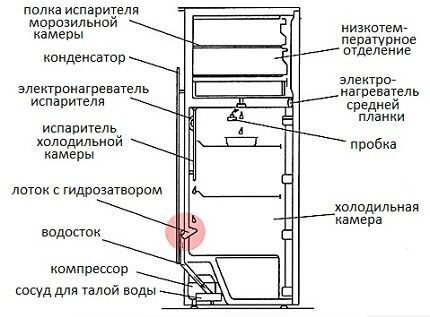
In practice, it looks like a small bend in which all unnecessary contaminants can be retained. To clean the hydraulic seal, the manufacturer offers special tools that need to be used to clear the hole from accumulated contaminants from time to time.
At the same time, the outflow of water is improved. If the drainage is clogged, such cleaning will not help. The blockage will need to be broken through.
This must be done extremely carefully, since the drainage system itself is a tube made of thin-walled plastic. It is best to take a fishing line with a diameter of 1 mm and melt its end smoothly.
The resulting improvised cable is lowered into the drainage hole and the system is cleaned. Then pour one and a half to two liters of warm washing solution into it and finally rinse with clean water.
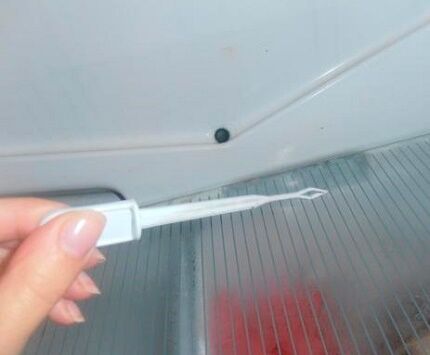
#5. Fuser, timer and fan in No Frost devices
“No frost” refrigerators are structurally more complex than “weeping” ones. Accordingly, there are more problems with them. Their main difference is the presence of a blower that drains excess moisture, which prevents the appearance of frost.
Experts consider the fan, fuser and timer to be the “weakest” points of such devices. You need to examine the fan from the freezer. Depending on the model of the refrigerator, the element can be open or closed.
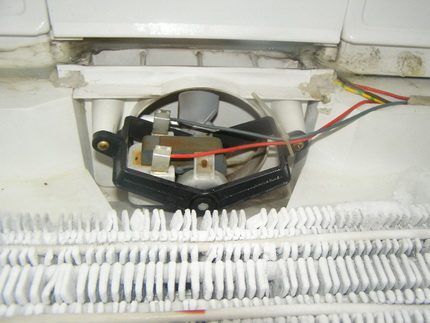
In the latter case, the assembly is covered with a lid with holes. For electronically controlled devices, open assemblies are usually used. The timer in this case is also electronic.
Such a tandem cannot be repaired independently; a master is needed. For simpler models with a removable cover and an electromechanical timer, repair is quite possible. First you need to carefully remove the cover.
Having reached the fan, you should carefully inspect it and try to turn the impeller with your finger. If it does not give in or is tight, you need to disassemble the unit. To do this, find a fastening plug.
It should be located on the axis of the device and may be covered with a branded sticker. Under the plug there is a washer, which can be made of plastic or metal. The first is diluted and removed using ordinary needles.
Steel is removed with pliers or special tools. Under this washer there are several more Teflon ones, which are carefully removed and stored. Next, the impeller along with the rotor is removed, cleaned and lubricated.
Experts warn that the lubricant must be chosen correctly. Only low-temperature formulations are used, otherwise they will thicken. After this, reassembly and performance testing are carried out. Maybe, refrigerator repair was quite successful and the problem was solved.

If not, all that remains is to check the operation of the fan.To do this, the unit is opened from the back, then you need to gain access to the device through which the fan is turned on. This can be either a mains filter or a low voltage filter.
To check, the fan is connected to the narrow standard terminals of the filter, and mains voltage is applied to the wide terminals. If the impeller does not start rotating, there may be a problem with the filter.
To verify this, remove a similar filter from the compressor cooling fan and repeat the experiment. If a breakdown is confirmed, the filter is replaced with a similar one. If everything is in order, you should check the fuser and the thermal trigger of the timer. They are located in the evaporator area.
First you need to remove the fuser from the connectors and ring it with a tester. The resistance should be zero. If not, we change the part, it is disposable. We first check the evaporator heating element for breakdown.
After this, you need to put all the disassembled parts in place and close the thermal control sockets with a jumper. This should only be done with the unit disconnected from the network. Then it is turned on. It should run on short cycle, not normal. If this is the case, the problem is in the thermal unit and needs to be replaced.
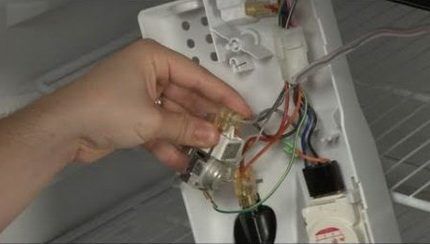
An important nuance. Such a check should be very short in time, literally 3-4 seconds, otherwise the timer will go off. If the timer does not work, most likely it is the cause of the problem. You should not try to repair it; experienced craftsmen can do it. It will be easier to replace the entire defective unit.
Conclusions and useful video on the topic
Algorithm for restoring the operating parameters of the Stinol refrigerator thermostat:
Video about the compressor replacement procedure:
Instruction video for those wishing to repair the Anti-frost system in the Stinol refrigerator:
Stinol refrigerators are of good quality and reliability. However, they also fail. If you have the desire and skills, of course, you can try to “revive” the unit on your own. You need to understand that this event may not always end successfully.
Unqualified repairs can only aggravate the situation and then you will have to fork out for more complex repair work or, which you really wouldn’t want, to purchase a new refrigerator.
Would you like to tell us about how you repaired a Stinol refrigeration machine with your own hands? Do you want to share useful information on the topic of the article and technological secrets? Please leave comments in the block below, ask questions, post photos.




It seems to me that you shouldn’t even try to repair a refrigerator yourself if you are not a master in this field. In any case, it is life-threatening, and even more damage can occur. You need to contact specialized service centers for this brand. By the way, can you tell me where in Moscow in the northern district such centers are located (addresses), with competent specialists in repairing this brand of refrigerators?
Hello. I’m a topographical nerd and I’m not good in the capital’s areas, so I can only recommend asking this question Here.
I can’t get the thermotube out of the Stinol refrigerator. Looks like it's oxidized. It seems like I'm pulling hard, but it doesn't give in. Are there ways to get it out? I'm afraid to break it.
The refrigerator began to freeze very much, I turn the regulator until it clicks (to the left) and it turns off, until it clicks to the right it turns on and starts freezing (milk, potatoes, etc. freeze), what could be the reason?